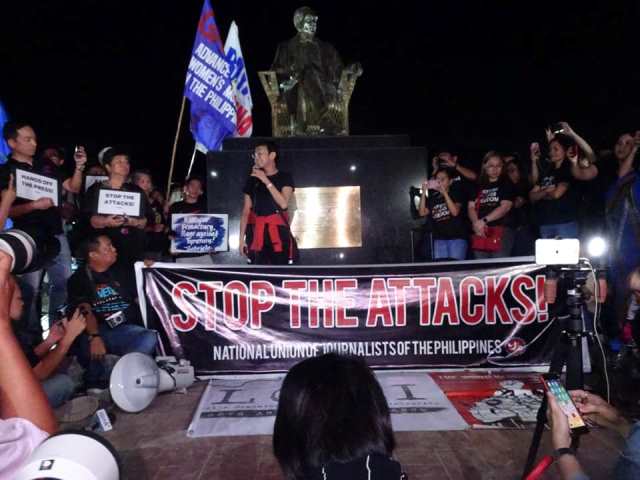Ressa’s Arrest: Limited Appreciation of Press Freedom

Journalists,
KNOWN FOR its critical coverage of the Duterte administration’s policies, Rappler, an online news site, was subjected to another form of harassment when its CEO and executive editor Maria Ressa was arrested and detained overnight on a charge of cyberlibel. Agents of the National Bureau of Investigation (NBI) served the warrant on Ressa at the Rappler office in Pasig City past 5 o’clock in the afternoon on February 13.
Other media organizations and the public were informed of the arrest when Rappler broke the news on its social media accounts. Journalists promptly went to the Rappler office, and followed Ressa and her lawyers to the NBI, covering the incident as it unfolded.
The cyberlibel case is only the latest in a series of threats against the news organization which is also facing the revocation of its license to operate and five tax evasion cases. It has also been banned from covering Palace events. But the coverage of Ressa’s arrest demonstrated much of the media’s limited appreciation of press freedom and the consequence of attacks on the press institution and the public it serves.
CMFR monitored three top broadsheets (Philippine Daily Inquirer, Philippine Star, Manila Bulletin), four primetime news programs (ABS-CBN 2’s TV Patrol, GMA-7’s 24 Oras, TV5’s Aksyon and CNN Philippines’ News Night) and selected online news sites from February 13 to 19.
Reports from broadcast media that were covering the event live focused on the circumstances of the arrest and what legal actions Ressa would take. However, the specific case for which she was arrested was not adequately explained. It took another day for reports to provide a more coherent explanation of the charges against her.
Only News Night and 24 Oras reported that the cyberlibel case had already been junked by the NBI in February 2018, but that it was revived by the Department of Justice only a few weeks later.
In print, only the Inquirer provided this information. The Inquirer also recalled that last year, Ressa had been served a warrant for Rappler’s alleged tax evasion, but was able to post bail the same day at the Pasig Regional Trial Court.
Most news accounts neither provided the details on the other criminal cases against Rappler, nor the judicial actions that have been taken on these.
After Ressa’s release from NBI custody, the reports that followed mostly recorded the statements of groups that condemned the arrest. Reports also quoted President Rodrigo Duterte, who denied that he knew the complainant and that he was responsible for Ressa’s arrest. The coverage waned after Ressa posted bail.
Reports missed the larger context of libel in the country, with no mention of how common it has become for politicians to file libel cases against journalists who report negatively or reveal matters that possibly call attention to official misconduct. There was also no discussion of the criminal libel law which has served as a punitive measure against journalists, and the long campaign to classify libel only as a civil and not a criminal offense.
Aside from Rappler itself, the media seem uninformed about the dangers the attacks against Rappler pose to press freedom, to the press as an institution and to the public. Ressa’s arrest was treated as mere breaking news, with no background provided on the country’s criminal libel law which becomes part of the pattern of repression, with numerous attacks and threats on journalists around the country, including the killing of 164 journalists in the line of duty since 1986. The media tended to present the case as an isolated incident that the rest of the press need not worry about and can take in stride—as indeed, the National Press Club said in a statement.
Leave a Reply